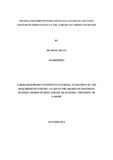| dc.description.abstract | The objective of the study was to establish the relationship between financial leverage and
asset growth of firms listed at the Nairobi Securities Exchange for the period 2009 to
2013.The study examined the theories of capital structure, determinants of asset growth and
reviewed empirical studies relevant to the study objective and is of value to investors and
managers in achieving in-depth understanding on the relationship between financial leverage
and the growth of firms listed at the NSE .The study adopted a descriptive research design
which seeks to define the relationship between two or more variables. The population of the
study consisted of sixty two firms listed at the Nairobi Securities Exchange out of which
thirty six companies were sampled. The sample excluded twenty companies listed under the
banks, insurance and investment segments because of the key fact that these companies are
regulated and are required to adhere to certain minimum liquidity and leverage ratios.
Another six companies were excluded from the study; two companies were newly listed and
therefore were not continuously listed over the period of study while another four companies
had missing information for some years required for the computation of the dependant and
independent variables. Secondary data was used in the study and this was collected from the
thirty six companies sampled. The sources of data included the Nairobi Securities Exchange
database and Annual Audited Financial Statements of the sampled companies. This data was
analyzed using Statistical Packages for Social Sciences (SPSS) version 22 and the results of
the regression and correlation analysis indicated an R-squared value of 0.299 revealing that
29.9% of the variation in asset growth was explained by financial leverage, return on equity,
size and age of the firm at 95% confidence interval. The regression analysis results further
indicate a positive but insignificant relationship between financial leverage and asset growth
of firms listed in the NSE. The financial leverage coefficient of +0.002 in the established
regression model indicates the positive relationship between the two variables. The reported
p-value of 0.998 is more than the critical value of 0.05 hence demonstrating the
insignificance of the relationship between financial leverage and asset growth. These findings
can possibly be explained by the indirect relationship between financial leverage and asset
growth and as such there are other factors that have a direct relationship with asset growth of
firms. The study made a policy recommendation that the management and investors of the
firms listed in the NSE should further examine other variables such as Return on Equity and
Size of the firm that notably have a more significant impact on a firms’ asset growth and
concentrate on the same to achieve higher asset growth rates and financial strength. The study
further recommended that an optimum capital structure that will support company growth
should be sought by managers of firms since excessive borrowing can lead to financial
distress and bankruptcy and hence limit growth. The study also recommended that investors
be guided by the findings of this study towards focusing on variables such as return on equity
and size of the firm that have a more significant impact on capital gains and investment
growth. | en_US |

